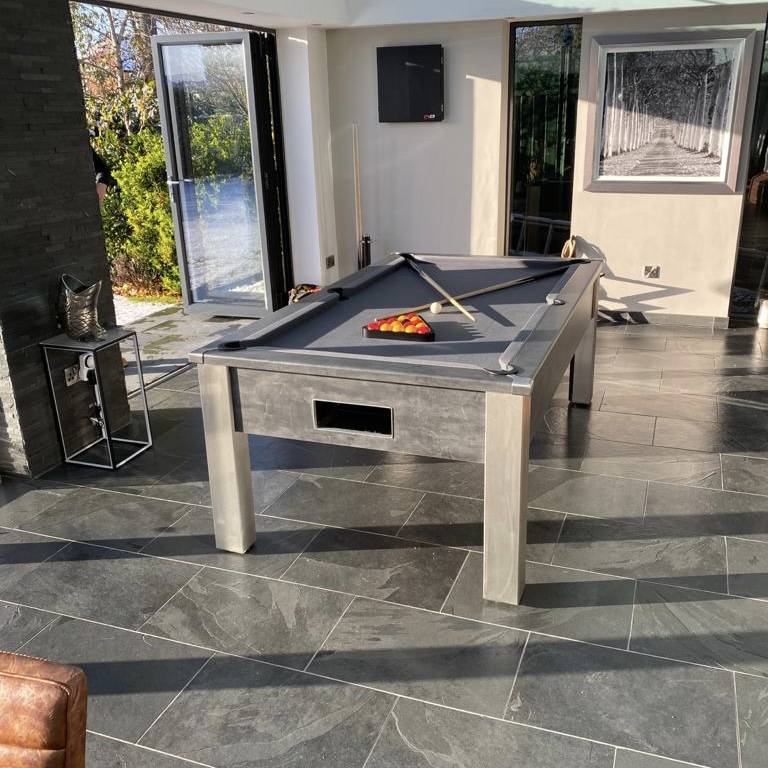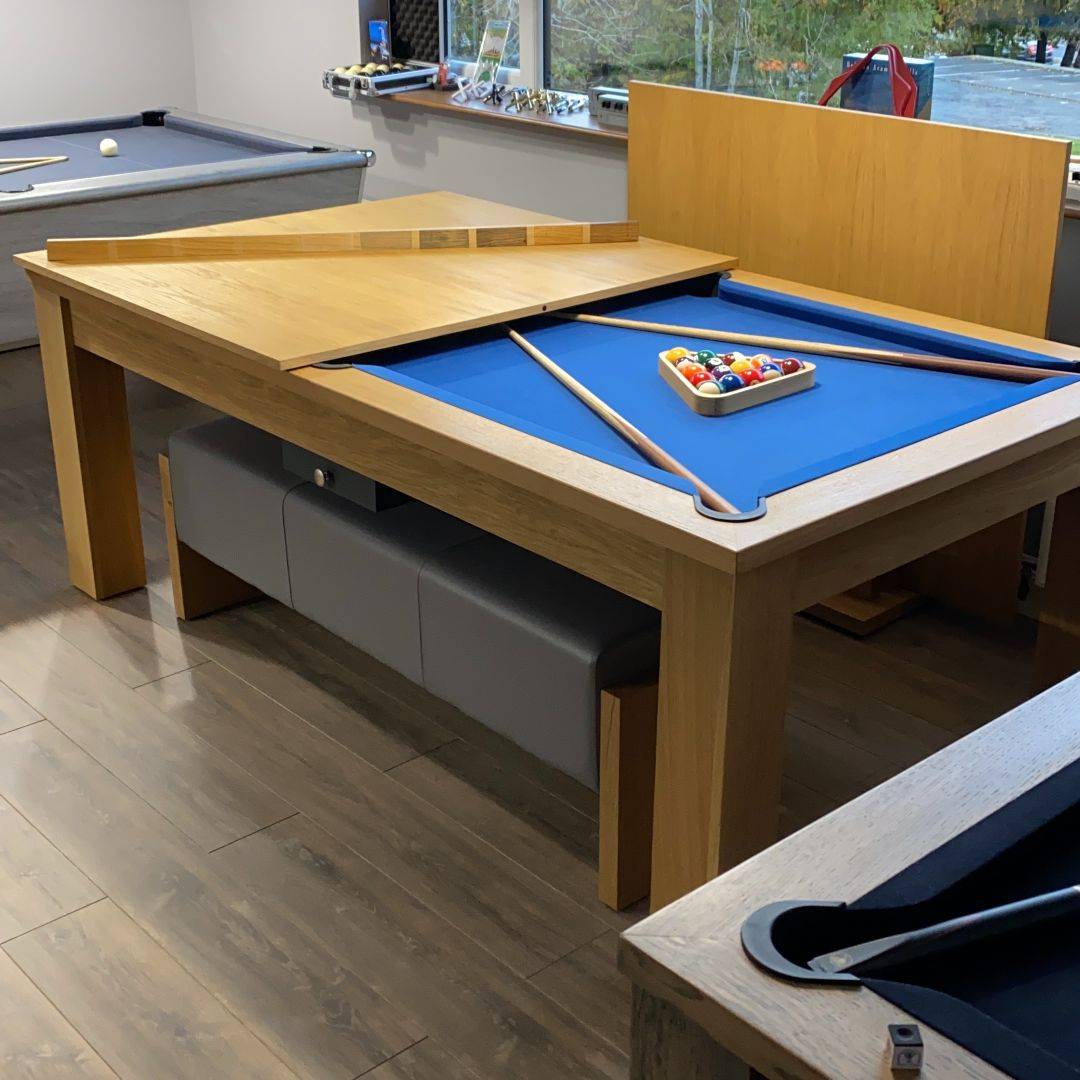Crafting Elegance: The Materials and Craftsmanship Behind Quality Pool Tables
The pool table, a centerpiece of game rooms and billiard halls worldwide, is not just a gaming platform but a work of art. The evolution from rudimentary tables to today’s elegant and high-precision tables is a testament to the mastery of craftsmanship and material science. Let’s embark on a journey to explore the beauty and intricacy behind the creation of a quality pool table.

1. The Heart of the Table: The Slate
At the core of every premier pool table lies the slate, a fine-grained rock that provides the flat, smooth surface essential for precise gameplay. Slate's choice for pool tables isn’t arbitrary; it’s favored for its durability, natural flatness, and resistance to warping.
Quality tables often utilize a 1-inch thick, three-piece configuration of slate, honed to a perfect level. These are then sealed together with a beeswax mixture, ensuring a seamless playing surface. The slate’s sourcing and treatment are paramount; Italian and Brazilian slate are particularly renowned for their exceptional quality.
2. The Framework: Strength and Stability
Supporting the hefty slate requires a robust framework. Hardwoods, especially oak, mahogany, and maple, are common choices. These woods lend sturdiness to the table, ensuring it remains stable despite the intense action it witnesses.
The artistry is evident in the intricate carvings, unique table leg designs, and the overall architecture. Skilled craftsmen often take days or even weeks to perfect the design, ensuring a balance between aesthetics and function.
3. The Surface: Cloth of Precision
While slate provides the flatness, it's the cloth that offers the smooth rolling surface. Traditionally made of wool, modern billiard cloths often incorporate a blend of wool and nylon, offering durability and a consistent rolling surface.
Brands like Simonis and Hainsworth have set industry standards, providing cloths that are not just functional but also come in various colors, allowing table owners to customize their look.
4. The Cushions: Rebounding with Accuracy
Another crucial component is the cushion, ensuring balls rebound with consistency. These cushions are typically made of natural rubber or synthetic materials that mimic rubber’s properties. Quality cushions ensure predictable ball movement, with craftsmen paying close attention to their attachment to the table, ensuring a flush fit.
5. The Pockets: More than Just Receptacles
Pockets are often overlooked, but they are essential both functionally and aesthetically. Leather pockets, with their durability and classic look, remain a favorite. However, they aren’t just about appearance. Their design ensures that balls entering them do so smoothly, without bouncing out or damaging the cloth.
6. The Art of Assembly
Crafting a quality pool table isn’t just about materials but the art of assembling them. Properly leveling the slate, ensuring the cloth is stretched uniformly without wrinkles, and guaranteeing that the cushions are fixed at the right height are all intricate processes. Each step requires skilled hands, patience, and a deep understanding of the game’s requirements.

7. Customizations and Modern Innovations
While traditional materials remain popular, there's an influx of innovation in pool table design. From LED-lit tables to transparent glass surfaces and smart tables that track ball movement using sensors, the fusion of technology and traditional craftsmanship is evident.
Moreover, customization options today are limitless. From personalized engravings to unique color schemes and even tables shaped uniquely (round, elliptical), craftsmen are continually pushing boundaries.
8. Sustainability in Craftsmanship
With increasing awareness about sustainability, many manufacturers are focusing on using sustainable woods and eco-friendly materials. Reclaimed wood tables, for instance, have gained popularity, offering a rustic look while being eco-friendly.
9. The Finishing Touches
The finish on a pool table isn’t merely for appearance; it protects the wood from moisture, ensuring longevity. While varnish and lacquer are standard, French polishing, a technique involving shellac and alcohol, offers a high-gloss, luxurious finish.
History of Pool Table Materials and Craftsmanship
The billiard table's origins trace back to the 15th century in Northern Europe, where it evolved from lawn games. Initially, these tables were simple wooden tables with flat surfaces covered with cloth, usually green to represent the grass of outdoor games.
Over time, as the game's popularity surged, so did the demand for better and more consistent playing surfaces. This led craftsmen to explore and incorporate slate as the preferred material for its unmatched flatness.
A Renaissance in Design: The Victorian Era
The Victorian Era witnessed a design renaissance for pool tables. Highly ornate tables with intricate woodwork and elaborate designs became the norm, especially in Europe. The materials used extended beyond function to symbolize status. Exotic woods, ivory inlays, and luxurious fabrics showcased a table owner's wealth and stature in society.
Modern Minimalism and Design Evolution
As with many things, pool table design experienced a shift in the 20th century, moving away from the ornate designs of the Victorian era to embrace minimalism. Sleek lines, simpler designs, and a focus on functionality became predominant. However, this didn’t mean a compromise on material quality; instead, it marked a shift in aesthetic preference.
Innovations in Material Science
The 21st century has brought about a fusion of traditional craftsmanship with modern material science. For instance:
- Nanotechnology: Some modern tables use nanotechnology treatments on their cloth, ensuring they remain spill-resistant, reducing the chances of staining or damage.
- Synthetic Alternatives: As sustainability becomes crucial, synthetic alternatives to traditional materials are gaining popularity. These not only reduce the environmental footprint but also offer durability and cost-effective solutions.
- Smart Tables: The digital age has seen the rise of "smart" pool tables. Embedded sensors, computer-assisted training systems, and even augmented reality (AR) enhancements provide players with real-time feedback, shot predictions, and game analytics.
Preservation of Traditional Techniques
Despite the technological advances and material innovations, there's a segment of manufacturers and enthusiasts dedicated to preserving the age-old craftsmanship techniques. Hand-carved designs, traditional joinery techniques, and the art of French polishing are skills passed down through generations, ensuring that the legacy of craftsmanship remains alive.
The Future: A Blend of Art, Science, and Technology
As we look ahead, the future of pool table design and craftsmanship appears to be an exciting blend of art, science, and technology. While the core principles remain rooted in providing the best playing experience, the avenues to achieve this are ever-expanding.
From materials that can self-repair minor scratches to tables integrated with AI for an immersive gaming experience, the boundaries are continuously being pushed. Yet, amidst all this, the essence remains – a dedication to crafting elegance, ensuring that each game played is not just a sport but an experience.

Conclusion
A quality pool table is the culmination of expert craftsmanship, the finest materials, and an understanding of the game's intricacies. It’s a blend of art and science, tradition and innovation. Next time you play a game, take a moment to appreciate the table beneath – its beauty, precision, and the hours of labor that went into crafting it.
Are you looking for a Pool Table? check out our pool tables range Pool Tables





